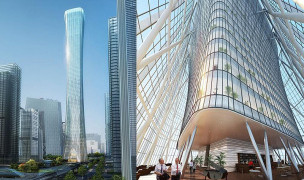 23 Terms
23 TermsHome > Terms > English (EN) > malls/shopping centers
malls/shopping centers
Perhaps no other urbanist innovation of American society in the twentieth century has gained such global interest—and critical opprobrium—as the “mall,” where the automobile, suburbanization and affluent consumerism converge. Yet, America’s variegated shopping complexes have now been replicated globally even in American (and other) urban centers. Malls, in addition, have become shapers of American life cycles.
Yet they remain simulacra—“Americas” in which the “other,” like bad weather, can be excluded and consumerism exalted.
Shopping centers emerged nationwide in the 1920s, via planned developments near Baltimore, MD, Cleveland, OH, and Kansas City and Northeastern train-based centers that also facilitated parking. Many were service-oriented, offering food stores, pharmacies, banks and perhaps a cinema or restaurant. This has remained the primary role of many “neighborhood” shopping centers, large and small, mushrooming at major intersections for drive-by errands. Yet, suburban consumers also attracted larger businesses, especially department stores, which established branches in automotive centers as well. Soon, these subsidiaries competed with downtowns, offering longer hours, convenience and class segregation of clienteles.
As suburbia grew, so did shopping centers. Victor Gruen Associates constructed the first enclosed two-story pedestrian malls at Southdale, near Minneapolis, MN, in 1955.
Malls later became differentiated in terms of their draw—local, regional and megaregional (Greater Philadelphia, PA’s mammoth King of Prussia has eight magnet stores in multiple buildings). As they grew, malls added attractions and services—food courts (with franchised food), movie cineplexes, office parks, theme parks, civic services and even hotels.
By the 1960s, downtowns not only competed with but imitated malls, as in Detroit, MI’s Renaissance Center or Chicago, IL’s multi-story Water Tower Place. Cities later found they could sell history or culture in festival marketplaces like Baltimore’s Inner Harbor or add malls to train stations and airports. Less conscious “malling” expanded in the 1980s as franchised stores and styles transformed older urban neighborhoods like SoHo, where Eddie Bauer, Prada and Pottery Barn occupy historic storefronts. The latest urban innovations include multi-story amusement malls like Disney Quest and high-tech centers by Sony and Nike.
Suburban shopping has also diversified. Giant outlet malls—anchored by manufacturers, discount sales and department store remainders—compete with both downtowns and upscale malls for a range of consumers. New immigrants, Asian and Latino, have constructed ethnic shopping centers/malls, especially in the Sunbelt. Yet conspicuous omissions include the long-term absence of new shopping complexes in Harlem, NY and South Central Los Angeles, CA.
Meanwhile, malls have reshaped American behavior. For many they offer one-stop anytime family outings, escaping bad weather outside. Malls cater to children with stores and holiday events—showcasing Santa Claus (once the domain of downtown department stores), and, in the 1990s, “safe” Halloween. In American mass media, mall life and teenagers are inseparable. Where 1950s movies featured teens at drive-in movies and restaurants, by the 1990s cars would be parked (or kids dropped off) outside malls. Sales of music, clothes, food and entertainment have recast suburban social life and dilemmas like teen shoplifting. For elderly consumers, malls offer social outings and secure exercise space (mallwalks).
Urbanist and media analyses of malls often prove harsh (Sorkin 1992; Clueless, 1995), belying the consumption that sustains ever more centers. Yet malls are not vital new public spaces either; their managements limit free speech, political actions and entry supported by federal courts. Malls also create problematic built environments in their reliance on automobiles and highways (with mega-malls so large one can drive “within” them), especially when, in local or national recession, one must ask what to do with a dead mall. Ultimately,, the most serious problems arise when the mall, as a shrine to consumerism, becomes a metaphor for education, belief, politics or identity. Yet this is not intrinsic to the mall itself, but to the society that finds its pleasures and reflections there.
- Part of Speech: noun
- Synonym(s):
- Blossary:
- Industry/Domain: Culture
- Category: American culture
- Company: Routledge
- Product:
- Acronym-Abbreviation:
Other Languages:
Member comments
Terms in the News
Billy Morgan
Sports; Snowboarding
The British snowboarder Billy Morgan has landed the sport’s first ever 1800 quadruple cork. The rider, who represented Great Britain in the 2014 Winter Olympics in Sochi, was in Livigno, Italy, when he achieved the man-oeuvre. It involves flipping four times, while body also spins with five complete rotations on a sideways or downward-facing axis. The trick ...
Marzieh Afkham
Broadcasting & receiving; News
Marzieh Afkham, who is the country’s first foreign ministry spokeswoman, will head a mission in east Asia, the state news agency reported. It is not clear to which country she will be posted as her appointment has yet to be announced officially. Afkham will only be the second female ambassador Iran has had. Under the last shah’s rule, Mehrangiz Dolatshahi, a ...
Weekly Packet
Language; Online services; Slang; Internet
Weekly Packet or "Paquete Semanal" as it is known in Cuba is a term used by Cubans to describe the information that is gathered from the internet outside of Cuba and saved onto hard drives to be transported into Cuba itself. Weekly Packets are then sold to Cuban's without internet access, allowing them to obtain information just days - and sometimes hours - after it ...
Asian Infrastructure Investment Bank (AIIB)
Banking; Investment banking
The Asian Infrastructure Investment Bank (AIIB) is an international financial institution established to address the need in Asia for infrastructure development. According to the Asian Development Bank, Asia needs $800 billion each year for roads, ports, power plants or other infrastructure projects before 2020. Originally proposed by China in 2013, a signing ...
Spartan
Online services; Internet
Spartan is the codename given to the new Microsoft Windows 10 browser that will replace Microsoft Windows Internet Explorer. The new browser will be built from the ground up and disregard any code from the IE platform. It has a new rendering engine that is built to be compatible with how the web is written today. The name Spartan is named after the ...
Featured Terms
amphibians
There are many Amphibians in sinharaja rain forest. One of the commonest frogs in the forest is the Wrinkled Frog heard frequently from marshes and ...
Contributor
Featured blossaries
Sanket0510
0
Terms
22
Blossaries
25
Followers
Badminton; Know your sport
 23 Terms
23 TermsBrowers Terms By Category
- General seafood(50)
- Shellfish(1)
Seafood(51) Terms
- Plastic injection molding(392)
- Industrial manufacturing(279)
- Paper production(220)
- Fiberglass(171)
- Contract manufacturing(108)
- Glass(45)
Manufacturing(1257) Terms
- Fuel cell(402)
- Capacitors(290)
- Motors(278)
- Generators(192)
- Circuit breakers(147)
- Power supplies(77)
Electrical equipment(1403) Terms
- Festivals(20)
- Religious holidays(17)
- National holidays(9)
- Observances(6)
- Unofficial holidays(6)
- International holidays(5)
Holiday(68) Terms
- Automobile(10466)
- Motorcycles(899)
- Automotive paint(373)
- Tires(268)
- Vehicle equipment(180)
- Auto parts(166)





